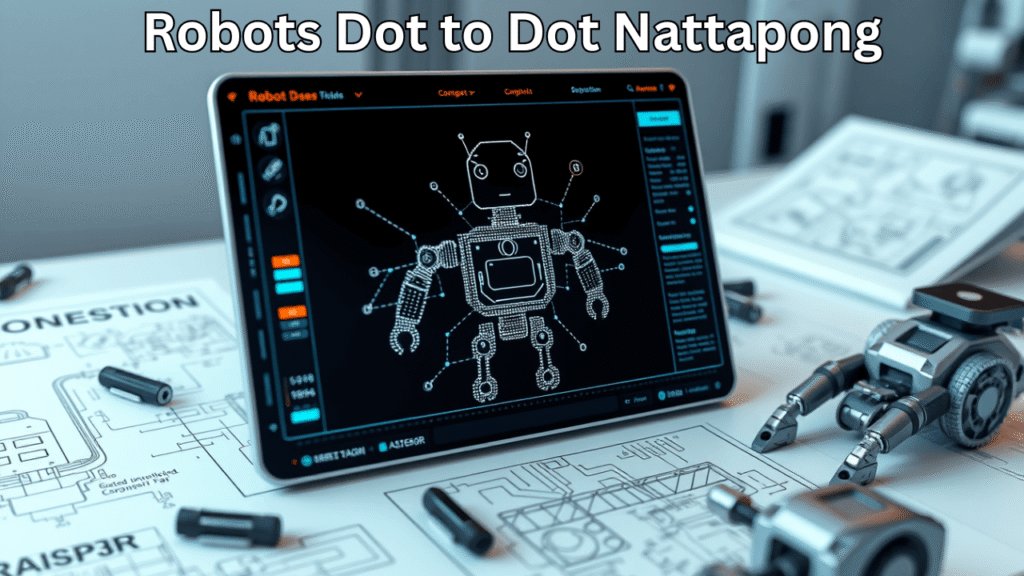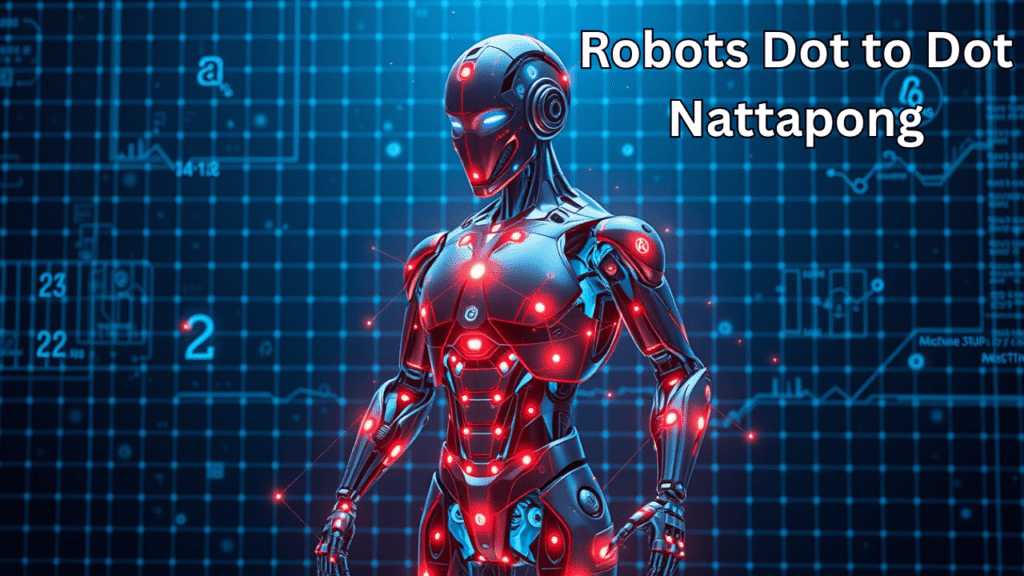Let’s talk about something that might sound like it came straight out of a sci-fi classroom but is actually very real—and seriously cool. Ever heard of Robots Dot to Dot Nattapong? No, it’s not a fancy robot name from a Marvel movie. It’s actually one of the most fascinating mashups of classic education and futuristic tech that’s making waves in the world of learning.
This concept takes the good old dot-to-dot puzzles we grew up with and wires them into the world of robotics—literally. Now, instead of just connecting dots with a pencil, students get to program robots to do it for them. Intrigued? Buckle up, we’re diving deep.
Back to Basics: What Is Robots Dot to Dot Nattapong, Really?
So, here’s the deal. Robots Dot to Dot Nattapong is a modern educational tool that blends two seemingly unrelated worlds: the simplicity of dot-to-dot puzzles and the complexity of robotics.
Picture this—you’ve got a puzzle made of numbered dots on a grid. But instead of your hand drawing the lines, a robot follows a code you write to connect them. You’re not just solving a puzzle, you’re commanding a mini machine to do it. Pretty neat, right?
Also Read
This method doesn’t just jazz up an old-school activity. It transforms it into a hands-on, brains-on learning experience. That’s the kind of innovation educators and students are getting excited about.
How Did We Get Here? A Quick Look at the History
From Crayons to Coding
Remember those coloring books with dot-to-dot pages? Simple stuff that helped us learn counting, shapes, and coordination. Well, those humble pages laid the groundwork for this tech-infused version. Over time, education has embraced interactivity—and that’s where robots walked in.
A Classic Activity Meets a Digital Makeover
Dot-to-dot puzzles have always been a subtle brain workout, helping with focus, motor skills, and visual learning. When combined with robotics, they become something much more interactive and intellectually engaging. That’s what Robots Dot to Dot Nattapong is all about—bringing together the charm of the old and the spark of the new.
The Man Behind the Machine: Who Is Nattapong?

Let’s not forget the human brain behind all this tech.
Meet Nattapong
Nattapong is a well-known name in robotics and education tech circles. His work? It’s all about making learning less of a chore and more of an adventure. Think of him as a modern-day inventor who decided kids should learn programming and problem-solving in the most fun, engaging way possible.
He didn’t just think up the idea—he brought it to life. With user-friendly robotic kits and smart AI integrations (yes, chatbots too), Nattapong made sure this wasn’t just for tech geniuses. Anyone—from a curious 6th grader to a skeptical high schooler—can get on board.
Innovations That Matter
Nattapong’s real genius lies in making robotics feel accessible. His systems are built for learning, with intuitive interfaces and tools that make complex concepts digestible. It’s not about just playing with bots—it’s about learning through them.
Why Educators (and Kids) Are Loving It
Brain Gains: Boosting Cognitive Skills
You’re not just building a picture here—you’re building logic. Students get to sharpen skills like:
- Critical thinking
- Sequencing
- Spatial awareness
- Problem-solving
Programming a robot to follow a path isn’t guesswork. It’s logic, planning, testing, and adapting.
Making Problem-Solving Fun
Let’s face it—most students would rather play with gadgets than fill out worksheets. Robots Dot to Dot Nattapong sneaks in the learning by turning it into a challenge: Can you code the robot to finish the puzzle correctly?
It’s like sneaking vegetables into pizza—kids are learning without even realizing it.
Interactive Learning That Sticks
The hands-on, trial-and-error nature of these activities hooks students in. And once they’re engaged, the retention goes way up. It’s not passive learning; it’s active, involved, and even a bit competitive (in a good way).
If you’re fascinated by how old-school activities are being reimagined with futuristic twists, you’ll also love exploring how AI is reshaping creativity. Check out my blog on Gramhir.pro AI Photo Generator 2025: Full Guide & Review—it dives into how artificial intelligence is revolutionizing the way we create and share visual content.
So, How Does It All Work?
Breaking Down the Basics
At the heart of this tool is a simple concept: students design a dot-to-dot puzzle, then program a robot to complete it by following specific instructions. The robot doesn’t guess—it follows what’s been coded into it.
What You’ll Need
A few key tools come into play:
- A programmable robot (yep, the real deal)
- An easy-to-use programming interface
- Dot-to-dot puzzle templates (or custom-made ones)
- A curious mind ready to tinker
Put them together, and you’ve got a mini-lab that turns theory into action.
Inside the Classroom: How It’s Being Used
Curriculum-Friendly Fun
Teachers love this because it fits into all sorts of subjects—math, science, tech, even art. It’s not just a cool side activity; it can reinforce real classroom content in a way that’s hands-on and student-driven.
Real-World Examples
Schools that have adopted Robots Dot to Dot Nattapong are already seeing the results. Increased engagement, improved problem-solving, and a whole lot of excited students. Case studies show that once kids get the hang of it, they’re often eager to explore more advanced robotics and coding topics on their own.
What’s the Catch? Challenges to Consider
Tech Isn’t Always Easy
Of course, not everything is smooth sailing. Setting up the hardware, learning the software, and debugging codes—it’s a process. It can be intimidating for teachers who aren’t tech-savvy, and some students might struggle at first.
Cost and Accessibility
Then there’s the money side. Robotic kits and programming tools don’t come cheap. Schools need budgets and support to make this work long-term. But the good news? More affordable kits are becoming available.
Looking Ahead: What’s Next for Robots Dot to Dot Nattapong?
Tech on the Rise
As AI and robotics keep evolving, so will this learning method. Expect more intuitive interfaces, AI-assisted programming help, and possibly even voice-controlled bots in the near future.
Augmented Reality? Yep, It’s Coming
Imagine combining dot-to-dot puzzles, robotics, and AR. Suddenly, students aren’t just watching robots draw—they’re seeing puzzles come to life in 3D. That’s where things are heading, and it’s going to be wild.
Final Thoughts: More Than Just Connecting Dots
In a world where attention spans are shrinking and tech distractions are everywhere, Robots Dot to Dot Nattapong is a breath of fresh educational air. It blends creativity, logic, and hands-on learning in a way that feels natural, fun, and meaningful.
This isn’t just about drawing lines. It’s about building future thinkers—one dot, one bot, and one brilliant idea at a time.
FAQs: Quick Answers You Might Be Looking For
Q: Who’s it for?
Kids of all ages—though complexity should match the learner. Elementary to high school, there’s something for everyone.
Q: Do you need fancy gear?
Not necessarily. While advanced kits are awesome, beginner sets and budget-friendly tools are out there.
Q: How do teachers use this in class?
Think math, science, and tech lessons—with a creative twist. Robots Dot to Dot is a powerful supplement to traditional teaching.
Q: What challenges might pop up?
Cost, tech complexity, and the learning curve. But with proper training and support, those are manageable.
Q: Where can I learn more?
Educational tech websites, robotics supply platforms, and academic journals are great starting points.
Explore the cutting-edge of legal tech with AI Legal Assistants: Transforming Legal Compliance and Risk Management, where artificial intelligence meets real-world legal challenges.





